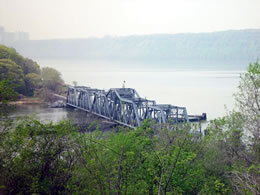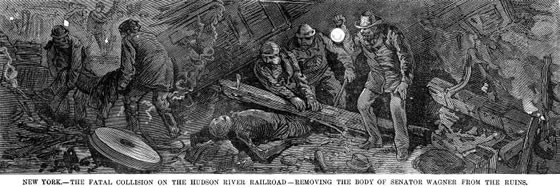The Spuyten Duyvil Swing Bridge tells an interesting story that intertwines the history of New York City with the Hudson River Valley.
 The New York & Hudson River Railroad was incorporated on May 6, 1847, to connect New York City with New York State. The original stock subscription for the company was 30,165 shares amounting to $3,016,500. There was also an initial cost of $9,000,000 for construction. One of the purposes of the company was to provide service for passengers and cargo that was faster than shipping along the Hudson River, especially during the winter months when the river froze.
The New York & Hudson River Railroad was incorporated on May 6, 1847, to connect New York City with New York State. The original stock subscription for the company was 30,165 shares amounting to $3,016,500. There was also an initial cost of $9,000,000 for construction. One of the purposes of the company was to provide service for passengers and cargo that was faster than shipping along the Hudson River, especially during the winter months when the river froze.
The first tracks were opened on September 29, 1849, running from Manhattan (Chambers Street) to Peekskill along the eastern shore of the Hudson River. By December 31st of that year, the system was extended to Poughkeepsie and then finally to Albany. At the Spuyten Duyvil a wooden trestle was constructed to connect Manhattan with the Bronx.
The total track mileage was 143 and 1/4 miles, and the tracks were laid five feet above high tide and included eight tunnels. One of the advantages of the location of the tracks was easy access to the water for the steam engines.
In Manhattan there had been a shuttle run between 30th Street and 10th Avenue and the Spuyten Duyvil Station in the Bronx. Along the route on the shore of the Hudson River, there were four station stops, which were 128th, 152nd, 177th and Dyckman Street. With the exception of the 177th Street depot, every stop had a ferry connection to New Jersey for passengers.
At 177th Street (or Depot Lane as it was known) and Cabrini Boulevard was a restaurant known as the Arrowhead Inn, run by Benjamin Riley. Also near the station in what is now Fort Washington Park was the West End Hotel.
During the 1860 presidential campaign, Abraham Lincoln used the line for his trip to various cities to make speeches. Two years later, Commodore Cornelius Vanderbilt purchased stock in the New York & Hudson and New York & Harlem River Railroad Companies, changing the name to the New York Central Railroad and shifting service to Grand Central Station. The Commodore, who made his money in shipping, had overcome his aversion of railroads, which may have been traced back to an injury he received in a train wreck in 1833 on the Camden and Amboy Railroad.
On January 13, 1882, disaster struck in the Spuyten Duyvil section of the Bronx just north of the railroad trestle where the tracks of the Hudson River and the Harlem River lines converge to go upstate. Two trains collided, causing many deaths and injuries. Railroad cars erupted into flames, and axes and buckets were not available for rescue and fire extinguishment.
The incident was reported in the January 21, 1882, issue of the Harper’s Weekly. One of the deaths reported in the crash was that of New York Senator Webster Wagner (1817-1882) who was on his way back to Albany. Wagner, who resided in Palantine Bridge, was elected to the New York State Assembly in 1871. He afterward served several terms in the Senate, of which he was a member at the time of his death. Senator Wagner was involved in the design of sleeping and palace cars for the railroads. His designs were put on the Utica and Schenectady Railroad in 1858.

The cause of the accident was the lack of signals in the area, which had not been instituted in the first place. There was an inadequate precaution of criminal negligence of the flagman who failed to warn the approaching train from Tarrytown or the engineer of the north-bound train had not been observant enough to look more closely when doing the turn at high speed. At this particular site it was impossible to see more than 100 feet ahead. Since that time a system of signals has been installed in the area.
In 1899 the original wooden bridge was replaced with a steel bridge designed by Robert Giles, an employee of the railroad company. The length of the bridge is 610 feet. It has three fixed sections on the Manhattan side and one on the Bronx side. The 290-foot central section pivots on a turntable which used to be operated by a steam engine. In 1963 the steam engine was replaced with an electrical engine.
In 1934, as many as 70 trains were traveling over the trestle, most of which were freight lines. Regular freight service had stopped by 1982. During this period Penn Central operated the bridge, thus regulating the amount of shipping and boats between the Hudson River and the Harlem River Ship Canal.
A hit-and-run by a Circle Line boat left the swing bridge section of the trestle in an open position in 1983 and lay dormant, forcing the tracks to be withdrawn from serving the freight routes. The incident was ruled an accident due to the heavy tidal current in the area. The Circle Line lobbied to keep the bridge open so that it would not impede the boats which ran every 20 minutes.
The accident necessitated complete rehabilitation of the trestle and swing bridge. A new electric engine was added to the swing bridge to allow for rail and nautical traffic. At the start of work, the metal was so corroded that very extensive sandblasting and replacement of plates would be required after the metalwork was removed.
The bridge was repaired and is now manned so that when one of the Circle Line boats approaches, the bridge is swung open to allow passage. This is done when the pilot of the boat calls ahead by radio on the Harlem River.
On April 7, 1991, Amtrak rerouted their trains from Grand Central Station to Penn Station to establish the New York to Albany run along the Hudson River on the path of their ancestral steam engines. This would make Inwood a vital link to both cities. This route offers a fantastic vista of the Hudson River and Valley as it passes through northern Manhattan over the bridge and then through the Bronx that served the line for over a century and one half.
Metro North still runs on the tracks on the Bronx shore of the Harlem River until the convergence north of the trestle at Spuyten Duyvil. From there the track is shared with Amtrak.
Schedule information for Metro North can be obtained from the MTA Web site or by calling 212-532-4900. Customer Relations can be reached at 212-340-2555. Amtrak schedules are available on their Web site or by calling 1-800-872-7245. Metroliner service and information can be reached at 1-800-523-8720. For more information on the Spuyten Duyvil train wreck and the death of Senator Wagner in 1882 visit Railroad Extra.
